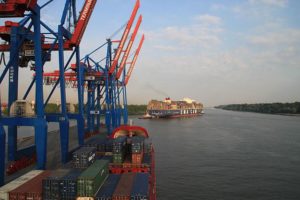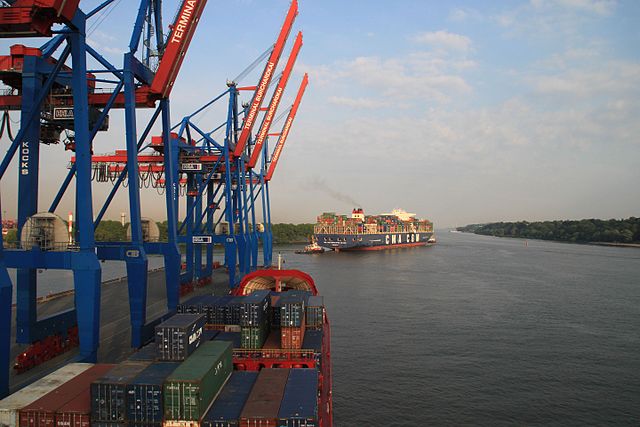 Although the container shipping industry enjoyed modest improvement in 2017, it still needs to address the dual challenges of rising costs and oversupply—driven mostly by fleet expansion—to keep the momentum going, according to a new report by AlixPartners.
Although the container shipping industry enjoyed modest improvement in 2017, it still needs to address the dual challenges of rising costs and oversupply—driven mostly by fleet expansion—to keep the momentum going, according to a new report by AlixPartners.
“The 2018 outlook for global container carriers is decidedly mixed,” said the report, while noting that the overall financial picture last year showed some year-over-year improvement for the shipping sector.
In 2017, EBIT rose to 3.2 as a percentage of revenue from 2016’s dismal 0.4%. In addition, the number of carriers with negative EBITDA dropped to two in 2017 from five in 2016.
Freight rates were stronger in the first half of 2017, but they remained low in a wider historical context. Generally, they’ve settled back to where they were before the Hanjin Shipping Co. bankruptcy in late 2016, said the report released this month.
Despite last year’s modest upturn, however, there’s no guarantee of a similar increase in cash from operations in the year ahead, said the U.S.-based international business advisory firm.
“Indeed, rates remain mired at relatively low levels because of the constant threat of overcapacity,” said the paper.
Fleet growing again
The total fleet, now estimated at 20,356,000 TEUs, is conservatively expected to grow this year by 4% to 5% compared with 3.3% in 2017.
And since September 2017, carriers have ordered 20 new ships with a combined capacity of 440,000 TEUs.
Total new container ship capacity of around 1.3 million twenty-foot equivalent units (TEUs) is due for delivery in 2018, and about 30% of that new capacity will be for mega ships of 18,000 to 25,000 TEUs.
The result is that the new capacity—much of it in the form of mega vessels—is significantly outpacing scrappage and therefore resulting in industry growth that is “dulling the effects of alliances and industry consolidation,” the report further said.
“Rates will continue to be squeezed as long as supply continues to outpace demand for containerized services. Consequently, total demand—at the very least—will have to meet expectations of a 4 to 5% increase to provide any real opportunity for margin growth,” said the report.
Operating expenses, too, are once again ticking up, partly due to rising bunker prices, even as larger customers have been rejecting surcharges such as the low-sulfur-fuel surcharge and frequently demanding contract rates with bunker adjustment factor included, thereby eliminating carriers’ ability to pass on fuel price fluctuations.
“Consequently, carriers will have to step up other efforts to manage expenses and lower the cost base,” the report stated.
Furthermore, the industry remains susceptible to “black-swan” events, ranging from the impacts of shifting geopolitics to cyber attacks.
“After a year of harsh rhetoric and rancorous negotiations, it remains unclear what impacts Brexit, America First policies, and volatile financial markets might have on specific demand and routes,” said the paper.
“Although the global economy started the New Year with broad strength, the potential remains for the development of political crises, for major corrections in the financial markets, and for ongoing dangerous cyberattacks such as the 2017 breach of Maersk Line, which the company said cost it an estimated $200 million to $300 million.”
Opening for opportunities
But the study also saw a number of opportunities for carriers to significantly improve performance through effective management in areas actually within their control.
These areas include pricing discipline. Ongoing fleet consolidation has created a situation wherein the five top carriers will now control almost two-thirds of global capacity.
“That realignment of ownership creates a unique opportunity for the industry to demonstrate a level of price discipline that has been lacking for years,” the report said.
Another is operating expense management. Although carriers have improved their capacity management skills, they have yet to produce the anticipated cost savings from fleet consolidation. Therefore, major opportunities remain for fleet operators to make dramatic cuts in redundant expenses and to modernize operations.
“Finally, it is imperative that carriers curb their voracious appetites for new ships. New orders slowed, and deliveries were deferred during much of 2017, but in September, the buying spree resumed in earnest, thereby ensuring the continuation of the current margin-crushing balance of supply and demand unless scrappage activity accelerates dramatically.”
In 2018, the report said, the impacts that might result from the industry’s reconfiguration into two tiers—the five large global players and about two dozen much smaller players, many of which compete either as specialists or exclusively in niche markets—will likely be seen.
Said AlixPartners: “The traditional second tier of midsize carriers has been absorbed by the giants. As controlling power within the industry stabilizes, it becomes more important than ever for carriers to step up their efforts to improve their performance, discipline their investments, and sharpen their strategies for succeeding through scale or specialization.”
Photo: Eduard47





